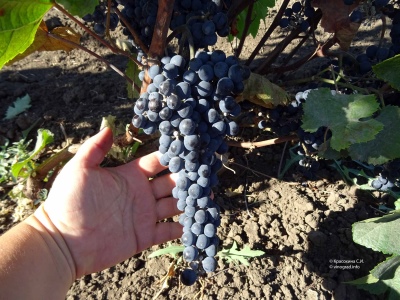
- Authors: ME AND. Potapenko, A.I. Potapenko, L.I. Proskurnya (VNIIViV named after Ya.I. Potapenko)
- Appointment: technical
- Berry color: black
- Ripening period: average
- Ripening period, days: 135
- Frost resistance, ° C: -30
- Bunch weight, g: 110-149
- Yield: 124-188 c / ha
- Flower type: bisexual
- Wine tasting evaluation, points: 7,5
The Bruskam variety, well-known to professional winemakers, belongs to the technical subspecies of grapes. When breeders were bred, the task of obtaining a plant resistant to the negative effects of climatic and other external factors was achieved. Bruskam has become quite popular among private winegrowers.
Breeding history
Bars obtained by crossing Bruskovatenky x Vitis amurenzis grapes in the Ya. I. Potapenko VNIIViV. It was first announced in 1970, but the variety appeared in the state register only in 1994.
Description
The grapes are medium-sized, with the number of fruiting shoots in the range of 85-90%. The bush is beautiful, up to 1 m high, with large leaves of juicy green color. The vine is beige-brown. Plants have a developed root system, easily and quickly take root in a new place.
Ripening period
Bruskam reaches technical maturity in 135 days. Already in August, the berries are colored, but they need additional time to reach full ripeness. The collection is carried out from the 2nd decade of September.
Bunches
The clusters on the bush are dense, cylindro-conical in shape, weighing 110-149 g. Each cluster has a pronounced wing and leg of medium length.
Berries
The grape bears fruit of medium size with black skin. The pulp is juicy inside, without the taste of wild grapes. The berry is rounded, weighing 1.6 g. There is a matte prune bloom on the skin.
Taste
Wines from Bruskam receive a tasting rating of 7.5 points. Its berries are not eaten, they are used exclusively as raw materials for processing. The sugar content is 210-220 g / dm3, acidity is 9.1-11.6 g / dm3.
Yield
Depending on the growing conditions, up to 124-188 kg / ha are harvested. The variety is considered a high-yielding variety; signal clusters can be expected as early as 2 years from the moment of planting.


Growing features
Bruskam is a variety well adapted to growing in different climatic zones. It requires virtually no special care. When growing, the number of bunches is regulated. The variety is not prone to peas. It tolerates heat and dry periods well, without signs of wilting.
Landing
Bars can be planted with cuttings or ready-made independent plants from nurseries. The distance between the holes is kept in the range of 1.5 m or more, the row spacing is left at 3 m. Such a planting scheme will allow the plants not to experience a deficit of sunlight. For growing grapes of this variety, forest or chernozem soils with a high content of potassium and phosphorus, humus, loose and fertile are well suited.

Pollination
The flowers are bisexual, pollination occurs naturally. Planting other grapes nearby is not required.
Pruning
No more than 8 eyes are left on the vine when pruning. Normalization of loads in the first years is mandatory. Leave about 2 bunches for a fruitful shoot, later this amount can be increased. The maximum load on the vine should not exceed 3 kg, otherwise it will affect the sugar content of the berries.



Frost resistance and the need for shelter
The variety has been successfully adapted to growing in climatic zones with a drop in atmospheric temperatures down to -30 degrees. Shelter for the winter is not required for him when grown in a high-stem culture.

Diseases and pests
The variety has a high resistance to mildew - at the level of 1 point. He is also weakly susceptible to other fungal diseases. Preventive treatments are optional but may be required during periods of heavy rainfall.

If a grape is exposed to any disease or insect, this always affects its appearance.
Storage
Berries are not subject to long-term storage after removal from the bush. They are immediately recycled. With late removal from the bush, there may be an increased sugar content, withering of the berries. With prolonged storage, the fruits begin to crack.
Review overview
According to the owners, Bruskam can be called one of the most attractive varieties for private winemaking. The resulting material is often compared with the more famous Cabernet Sauvignon, indicating that its quality, if inferior to its eminent brother, is not much. The appearance of the bunches was also highly appreciated, and the leaves are recommended to be used for dolma: they are soft, without excessive coarseness. The owners agree that Bruskam is fully consistent with the level of disease resistance declared by the breeders: even beginners in viticulture hardly have to deal with them.
Of the shortcomings of the variety, there is some discrepancy in the ripening dates of berries on the bushes. Even within one year of planting, the interval is up to 7 days. Sugar gain is also quite slow: up to 3-4 weeks. It is mentioned that wasps do not show much interest in berries, but bushes with ripening crops have to be protected from birds with nets.











































































